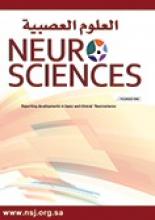Abstract
OBJECTIVE: To assess the clinical categories, laboratory, radiological findings, and treatment outcomes of patients with neurobrucellosis.
METHODS: This retrospective study was designed at the Infectious Diseases and Clinical Microbiology Department, Faculty of Medicine of Gaziantep University, Gaziantep, Turkey between 2003 and 2006. In this period, 300 patients with brucellosis were diagnosed, and 13 patients with neurobrucellosis are described. Diagnosis of neurobrucellosis was based on the isolation of Brucella spp. from CSF and/or CSF standard tube agglutination (STA) >/=1/40, lymphocytic pleocytosis, increased protein in CSF and STA >/=1/320 in blood. The mean adenosine deaminase level was 12.15 u/L in CSF. The duration of antimicrobial treatment varied with the clinical response of the patient.
RESULTS: We divided the 13 patients with neurobrucellosis into 4 different groups according to clinical presentation: meningoencephalitis in 8 patients, cerebral demyelination in one patient, myelitis in one patient, and neuropsychiatric disorder in 3 patients. The most common clinical form of neurobrucellosis was meningoencephalitis. There was no mortality in any of the cases.
CONCLUSION: Applying these diagnostic criteria can help both early diagnosis of neurobrucellosis and differentiation from other CNS involvement in endemic regions.
- Copyright: © Neurosciences
Neurosciences is an Open Access journal and articles published are distributed under the terms of the Creative Commons Attribution-NonCommercial License (CC BY-NC). Readers may copy, distribute, and display the work for non-commercial purposes with the proper citation of the original work.






